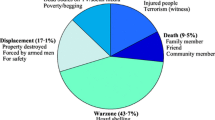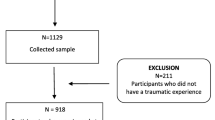Abstract
Background
The war in northern Uganda has had a debilitating effect on the mental health of children and adolescents in the population. This study measures the prevalence and considers the aetiology of psychological distress in war-affected adolescents 4 years after the end of the conflict.
Methods
This is a cross-sectional study of 205 adolescents, aged 12–19, from a boarding primary school in Gulu, northern Uganda. A war experiences checklist was developed with the assistance of local professionals. The Impact of Event Scale-Revised (IES-R) measured post-traumatic stress symptoms. Finally, the Acholi Psychosocial Assessment Instrument (APAI) was used to measure locally described mental health constructs similar to the Western concepts of depression and anxiety.
Results
Four years after the end of the war, 57% of the students were still found to have clinically significant levels of post-traumatic stress symptoms using a similar cut-off score to previous studies among the same population. Both components of traumatic exposure: (i) the number of types of traumatic event experienced; and (ii) whether the adolescent was abducted were significantly associated with psychological distress. There was a strong correlation between post-traumatic stress symptoms and internalising symptoms.
Conclusion
War-affected adolescents may continue to suffer from significant psychological stress in the years following the cessation of conflict. Multiple exposure to a number of different types of traumatic event may directly increase the likelihood of psychological distress especially for those exposed to the most extreme violence. The feasibility of employing a locally developed and validated screening instrument is demonstrated. Implications for future research and intervention in post-conflict areas are considered.
Similar content being viewed by others
References
Barenbaum J, Ruchkin V, Schwab-Stone M (2004) The psychosocial aspects of children exposed to war: practice and policy initiatives. J Child Psychol Psychiatry 45(1):41–62
Neuner F, Catani C, Ruf M, Schauer E, Schauer M, Elbert T (2008) Narrative exposure therapy for the treatment of traumatized children and adolescents (KidNET): from neuro-cognitive theory to field intervention. Child Adolesc Psychiatry Clinics N. Am 17(3):641–664
Dyregrov A, Yule W (2006) A review of PTSD in children. Child Adolesc Mental Health 11(4):176
Schauer M, Schauer E (2010) Trauma-focused public mental health interventions: a paradigm shift in humanitarian assistance and aid work. In: Marz E (ed) Trauma rehabilitation after war and conflict: community and individual perspectives. Springer, New York
Coalition to Stop the Use of Child Soldiers (CSUCS) (2008) Child Soldiers Global Report 2008. Coalition to Stop the Use of Child Soldiers (CSUCS), London
Machel G (2001) The impact of war on children. Hurst & Company, London
Boothby NG, Knudsen CM (2000) Waging a new kind of war: children of the gun. Sci Am 282:60–65
Machel G (1996) Impact of armed conflict on children. Report of the Expert of the Secretary General of the United Nations. New York
Amone-P’Olak K, Garnefski N, Kraaij V (2007) The impact of war experiences and physical abuse on formerly abducted boys in northern Uganda. S Afr Psychiatry Rev 10(2):76–82
Machel G (2009). Machel study 10-year strategic review: children and conflict in a changing world. Office of the special representative of the Secretary-General for children and armed conflict in collaboration with UNICEF UN children’s fund. www.unicef.org/publications/index_49985.html. Accessed 2 July 2010
Annan J, Brier M, Aryemo F (2009) From ‘rebel’ to ‘returnee’: the reintegration of young soldiers in northern Uganda. J Adolesc Res 24:639–667
Derluyn I, Broekaert E, Schuyten G, De Temmerman E (2004) Post-traumatic stress in former Ugandan child soldiers. Lancet 363(9412):861–863
Amone-P’Olak K (2005) Psychological impact of war and sexual abuse on adolescent girls in northern uganda. Intervention 3(1):33–45
Karunakara UK, Neuner F, Schauer M, Singh K, Hill K, Elbert T et al (2004) Traumatic events and symptoms of post-traumatic stress disorder amongst Sudanese nationals, refugees and Ugandans in the West Nile. Afr Health Sci 4(2):83–93
Bayer C, Klasen F, Adam H (2007) Association of trauma and PTSD symptoms with openness to reconciliation and feelings of revenge among former Ugandan and Congolese Child Soldiers. J Am Med Assoc 298(5):555–559
Schauer E (2008) Trauma treatment for children in war. Build-up of an evidence-based large-scale mental health intervention in North Eastern Sri Lanka. Dissertation (PhD) thesis, University of Konstanz, Konstanz, Germany, Department of Clinical Psychology and Neuropsychology. http://www.ub.unikonstanz.de/kops/volltexte/2008/5424/
Ehntholt KA, Yule W (2006) Practitioner review: assessment and treatment of refugee children and adolescents who have experienced war-related trauma. J Child Psychol Psychiatry 47(12):1197–1210
Mels C, Derluyn I, Broekaert E, Rosseel Y (2009) Screening for traumatic exposure and posttraumatic stress symptoms in adolescents in the war-affected eastern democratic republic of congo. Arch Pediatr Adolesc Med 163(6):525
Smith P, Perrin S, Yule W, Hacam B, Stuvland R (2002) War exposure among children from Bosnia–Hercegovina: psychological adjustment in a community sample. J Trauma Stress 15:147–156
Thabet AA, Abed Y, Vostanis P (2002) Emotional problems in Palestinian children living in a war zone:a cross-sectional study. Lancet 359(9320):1801–1804
Goenjian AK, Molina L, Steinberg AM, Fairbanks LA, Alvarez ML (2001) Posttraumatic stress and depressive reactions among Nicaraguan adolescents after hurricane Mitch. Am J Psychiatry 158(5):788–794
Pham PN, Vinck P, Kinkodi DK, Weinstein H (2010) Sense of cohesion and its association with exposure to traumatic events, post-traumatic stress disorder, and depression in eastern Democratic Republic of the Congo. J Trauma Stress 23/3:313–321
Heptinstall E, Sethna V, Taylor E (2004) PTSD and depression in refugee children: association with premigration trauma and post-migration stress. Eur Child Adolesc Psychiatry 13:373–380
Mels C, Derluyn I, Broekaert E, Rosseel Y (2010) Community-based cross-cultural adaptation of mental health measures in emergency settings: validating the IES-R and HSCL-37A in eastern Democratic Republic of Congo. Soc Psychiatry Psychiatr Epidemiol 45(9):899–910
Taylor S, Thordarson D, Maxfiled L, Fedoroff I, Lovell K, Ogrodniczuk J (2003) Comparative efficacy, speed, and adverse effects of three PTSD treatments. J Consult Clin Psychol 71(2):330–338
Saigh PA, Mroueh M, Bremner JD (1997) Scholastic impairments among traumatized adolescents. Behav Res Ther 35(5):429–436
Laor N, Wolmer L (2002) Children exposed to disaster: the role of the mental health professional. In: Lewis M (ed) Child and adolescent psychiatry: a comprehensive textbook. Lippincott Williams & Wilkins, Philadelphia, pp 925–937
Joshi PT, O’Donnell DA (2003) Consequences of child exposure to war and terrorism. Clin Child Fam Psychol Rev 2003 6(4):275–292
Famularo R, Fenton T, Kinscherff R, Augustyn M (1996) Psychiatric comorbidity in childhood post traumatic stress disorder. Child Abuse Negl 20:953–961
Saltzman WR, Layne CM, Steinberg AM, Arslanagic B, Pynoos RS (2003) Developing a culturally-ecologically sound intervention program for youth exposed to war and terrorism. Child Adoles Psychiatr Clin N. Am 12:319–342
Weiss DS, Marmar CR (1997) The impact of events scale-revised. In: Wilson JP, Keane TM (eds) Assessing Psychological Trauma and PTSD. Guilford Press, New York
Betancourt T, Bass J, Borisova I, Neugebauer R, Speelman L, Onyango G, Bolton P (2009) Assessing local instrument reliability and validity: a field-based example from northern Uganda. Soc Psychiatry Psychiatr Epidemiol 44(8):685–692
Schauer M, Neuner F, Elbert T (2005) Narrative exposure therapy: a short-term intervention for traumatic stress disorders after war, terror, or torture. Hogrefe & Huber, Göttingen
Smith P, Dyregrov A, Yule W, Perrin S, Gjestad R, Gupta L (2002) Children and war: teaching recovery techniques. Foundation for Children and War, Bergen. Retrieved 15 May 2010 http://www.childrenandwar.org
Broidy L, Agnew R (1997) A general strain theory perspective. J Res Crime Delinq 34:275–306
Klasen F, Oettingen G, Daniels J, Post M, Hoyer C, Adam H (2010) Posttraumatic resilience in former Ugandan child soldiers. Child Dev 81(4):1096–1113
Derluyn I, Broekaert E, Schuyten G (2008) Emotional and behavioural problems in migrant adolescents in Belgium. Eur Child Adolesc Psychiatry 17(1):54–62
Betancourt T, Agnew-Blais J, Gilman S, Williams D, Ellis B (2010) Past horrors, present struggles: the role of stigma in the association between war experiences and psychosocial adjustment among former child soldiers in Sierra Leone. Soc Sci Med (1982) 70(1):17–26
Ovuga E, Boardman J, Wasserman D (2007) Integrating mental health into primary health care: local initiatives from Uganda. World Psychiatry 6:60–61
Summerfield D (1999) A critique of seven assumptions behind psychological trauma programmes in war-affected areas. Soc Sci Med 48(10):1449–1462
Smith P, Perrin S, Dyregrov A, Yule W (2003) Principal components analysis of the impact of event scale with children in war. Pers Individ Differ 34:315–322
Crumlish N, O’Rourke K (2010) A systematic review of treatments for post-traumatic stress disorder among refugees and asylum-seekers. J Nerv Ment Dis 198(4):237
Acknowledgments
With sincere appreciation and thanks to all the young people who participated in this study, to their teachers and caregivers and to our friends in Gulu without whom this study would not have been possible. The authors declare that they have no financial, personal, or professional interests that could be construed to have influenced their article.
Author information
Authors and Affiliations
Corresponding author
Rights and permissions
About this article
Cite this article
McMullen, J.D., O’Callaghan, P.S., Richards, J.A. et al. Screening for traumatic exposure and psychological distress among war-affected adolescents in post-conflict northern Uganda. Soc Psychiatry Psychiatr Epidemiol 47, 1489–1498 (2012). https://doi.org/10.1007/s00127-011-0454-9
Received:
Accepted:
Published:
Issue Date:
DOI: https://doi.org/10.1007/s00127-011-0454-9




